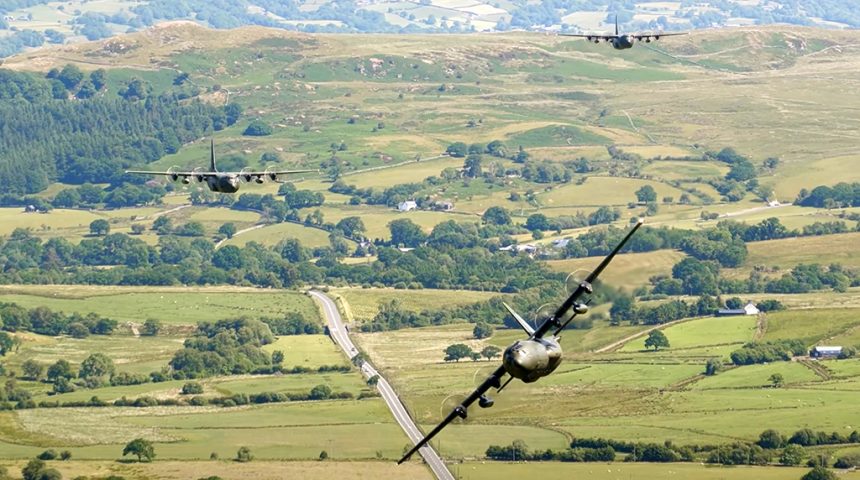Three C-130Js carried out a farewell flypast across the UK and also flew one last pass in the Mach Loop.
On Jun. 14, 2023, the Royal Air Force bid farewell to the C-130 Hercules with a flypast that brought three J-model aircraft from their homebase at RAF Brize Norton around the country. Flying over RAF stations and places of significance to the aircraft’s history, it was a fitting goodbye in preparation for its retirement scheduled later this month, on Jun. 30, 2023.
The three C-130Js were ZH870, flying as OMEN1; ZH868, OMEN2; and ZH871, OMEN3.
The OMEN formation flew to the National Memorial Arboretum, RAF Cosford, Valley, Lossiemouth, Leeming, Waddington, Cranwell, MOD Boscombe Down and of course the former RAF Lyneham. And, as part of the farewell tour, the flight also carried out one last pass in the Mach Loop where our friend Ben Ramsay of UK Aviation Movies shot the footage you can find below.
Watching the last low level pass
“Today was a pretty solemn day. I’ve been watching and filming these Royal Air Force workhorses for years in the Mach Loop, but today was their last low level sortie,” Ben wrote in the comment to the Youtube video. “Whilst it was absolutely awesome to see three Hercs emerge from the Bwlch pass, it was sad to see them fade into the distance over Tal-y-llyn Lake and out to sea for the last time.”
Axed by the Defense Review
The UK operated around 85 C-130s through its nearly 60-year career. In 2013, the service had already retired the C-130K models and, in March 2021, the UK’s Government published an Integrated Defence Review that introduced several significant changes to the British military. “The Royal Air Force will retire the BAe146 as planned by 2022 and take the C130 Hercules out of service by 2023. The A400M Atlas force will increase its capacity and capability, operating alongside C 17 Globemaster and Voyager transport aircraft and tankers,” the document stated.
Initially scheduled to remain in service until the mid-2030s, the remaining 14 C-130J aircraft, which first entered active service with the RAF in the late 1990s, will be retired within the end of this month.
RAF’s workhorse
Since 1999, the Hercules has been the RAF’s primary tactical transport aircraft, often referred to as the “workhorse” of the RAF’s Air Transport (AT) fleet. The mix of C.Mk 4 and C.Mk 5 versions of the C-130J-30 and C-130J operated by Nos 206, 47 and XXIV Squadrons at RAF Brize Norton in various roles: they were used primarily to carry troops, passengers or freight; for aeromedical evacuation; airborne delivery of personnel or stores by airdrop, and support to Special Operations.
According to the RAF website: “The aircraft is highly flexible, with the ability to airdrop a variety of stores and paratroopers, and operate from natural surface landing zones. To conduct these missions it is vital that Hercules crews are highly skilled in low-level flying. The aircraft performs in the same roles at night using night-vision goggles (NVGs), while station keeping equipment (SKE) enables it to remain in formation during poor weather. Long-range capabilities are enhanced with air-to-air refuelling, while the Air Survival Rescue Apparatus may be mounted in the cabin for search and rescue missions, enabling the Hercules to airdrop life rafts and emergency supplies.”
The aircraft is particularly valuable in crisis scenarios as it can be operated from unprepared and semi-prepared surfaces by day or by night. Its maximum unrefuelled ferry range is 3500 NM, which can be extended to over 4000NM by air-to-air refuelling. Moreover, the C-130s are fitted with defensive infrared countermeasure equipment, with some aircraft used for special tasks also featuring enhanced defensive-aids suite comprising a Skyguardian radarwarning receiver, a chaff and flare countermeasure dispensing system and a missile approach warning system.
In 2011, during the Libyan crisis which eventually led to the Air War in Libya, the RAF C-130s were tasked to rescue oil workers that were trapped in the desert. The airlifters took off from Malta and flew over the Mediteranean, called Tripoli air traffic control, explained who they were and what they were up to, they got no reply from the controllers, therefore continued at low level once over the desert and in hostile airspace.
The C-130Js’ workload should be mainly picked up by A400M Atlas transports. The service has received its first of 22 Atlas on Nov. 14, 2014. The Atlas aircraft are assigned to the Nos 70 Sqn and the 24 Sqn, that is Air Mobility Operational Conversion Unit. The 206(R) Sqn, acting as the Heavy Aircraft Test and Evaluation Unit, based at MoD Boscombe Down but with a flight detachment at RAF Brize Norton flies the A400M on loan from other squadrons when required to undertake specific testing activities.
BTW, on the day of the farewell tour, the three aircraft did not recover to Brize Norton as planned, but diverted to RAF Fairford because of issues with the temperature of the tarmac.
The @RoyalAirForce‘s three-ship #Hercules flypast around the country has landed at #Fairford rather than the homebase of @BrizeNorton because of restrictions associated with the temperature of Brize’s runway. Heat impacting operations on the RAF’s most important runway.
— Tony Osborne (@Rotorfocus) June 14, 2023









